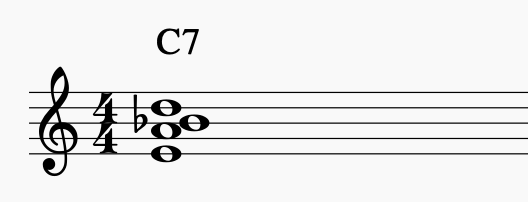The Pippinpotato Corner All things pippin and potato
Think in Terms of Scale Degrees, Not Just Notes
5 minute read

When you first start learning music, you learn note names. You learn how to read note names on a music staff and how to play the note on your instrument. When you learn a piece of music you learn it in terms of these note names. Take the tune “Someday My Prince Will Come” as an example:

You would read this as the series of notes, F-Bb-F#-A-G-G. This is perfectly right, but there is a next step to interpreting the note on the page. You should interpret the note as a scale degree of the incident chord/scale. This is “Someday My Prince Will Come” interpreted in this way:

F is the 5th degree of Bb major, Bb is the flatted 6th degree of D dominant, and so forth.
Why Do This?
The first reason you should think in terms of scale degree is that learning tunes, licks, or voicings in all the keys becomes easier. Through rigorous practice, your brain will be able to convert from chord + note to scale degree as well as chord + scale degree to note for all the keys quickly. This will improve your ability to learn tunes, licks, and voicings in all keys.
Another reason is that you learn to recognize the sound of each scale degree within its corresponding scale/against its corresponding chord. Each scale degree has a unique sound that is universal among all scales, and the sound of a single note can change depending on the chord its being played against.
Play both versions of “Someday My Prince Will Come” and listen to how the sound of the F and Bb in the first two measures differ between each version.


In the first version, the F is the 5th degree of a major seven chord, which makes it sound more firm and resolute. In the second version the F is the 9th degree of a major seven chord, which makes it sound softer (not in terms of dynamics, but in terms of texture… imagine a soft fleece blanket) as well as introduce a little tension/clash. Looking at the Bb, in the first version it is the flatted 6th degree of a dominant seven chord, which gives the note a lot of tension and clash. The Bb in the second version is once again the 9th degree and you can hear how it also sounds softer with a mild amount of tension/clash (listen for the tension between the melody and chord, not the tension within the chord itself).
Don’t worry if it’s difficult to hear these characteristics of these scale degrees right now. It was difficult for me to hear in the beginning, but through ear training and being conscious of scale degrees in my practicing, I began to hear the differences between the scale degrees. A good place to start is to recognize that the chord tones (1, 3, 5, 7) sound consonant and the other scale degrees (2, 4, 6) are dissonant.
Being able to hear the unique sounds of each scale degree is useful for reharmonization, improvisation, and a greater understanding of melody as a whole.
As you now may be beginning to realize, thinking in terms of scale degree is the more holistic way of approaching melody. Melody is not a standalone element of music; in tonal music it has a close relationship with harmony, and in modal music the sound of a note has ties with its position in the mode.
Thinking in terms of scale degree is an essential part of analyzing solos or melodies in general. It is one important aspect to understanding the solo and transferring the sound of the solo to your own playing without just conducting a rote memorization of the notes.
Practicing This
One of the tough parts of switching your thinking to scale degrees is creating the mapping in your head from chord + note to scale degree as well as chord + scale degree to note for all the keys. I practice this mapping when I practice voicings.
Take this rootless voicing for example:

When I practice this, I first close my eyes and tell myself the key I’m in (C). Then I tell myself the name of the 3rd degree (E) and visualize it on the piano. I repeat this with the 7th degree (Bb), 13th degree (A), and 9th degree (D). I basically start with the shell (3 and 7) as it’s the most important characteristic of each chord, and then work my way up the voicing for the rest of the scale degrees. After doing all this, I play the voicing on the piano.
In the beginning I only did this method with the shell and added the other scale degrees later. It’s difficult and sometimes counterproductive to try to learn too much at once.
I do this for all keys, working my way down one whole tone scale a day.


It’s a slow way of practicing voicings, but you get faster at it and it pays off.
Ear Training
The ear training method that puts emphasis on scale degrees over notes and helps you hear the sound qualities associated with each scale degree is the Alain Benbassat method. The gist is that you have someone first play a chord progression (I-IV-V-I) in a key, and then play a note in that key. Then you try to identify the note. I have found the Functional Ear Trainer phone app to be good for practicing this.
Final Note
Learning note names is a start, but identifying notes by their chord and scale degree will greatly improve your interpretation of music. It might take some time to instantly conjure up the note for each scale degree for each key, but the payoff is worth it.
Written on July 10th, 2020 by Chris Cheung